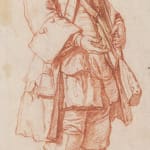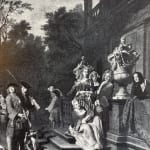
Jan Josef Horemans
The Return from the Hunt
oil on canvas
83,5 x 67,5 cm
signed and dated 1721
With Julius Böhler, Munich, in 1979.
Jan Josef Horemans (Antwerp 1682 - 1759)
Further images
Jan Josef Horemans I (“the Elder”) was born in Antwerp in 1682. He was the son of the Antwerp notary Jan-Joseph Horemans and his wife Maria-Magdalena Lowies. His brother, Peter Jacob, also became a painter. He was first registered in the Antwerp guild of St Luke in 1694/95, as a pupil of the sculptor Michiel van der Voort. Later he finished his training with the art dealer and genre painter Jan van Pee. In 1706/7 he became a fully-fledged member of the guild and in early 1707 he married Maria-Francisca, the daughter of his former master van der Voort. The pair would have no less than seven children. In 1716/17 his younger brother Peter Jacob entered his workshop as a student; later he would also train his son, Jan Josef the Younger, who collaborated with his father on several occasions, even after leaving his workshop.
Horemans (the Elder) was considered the leading painter of everyday life in Antwerp in the first half of the eighteenth century. He mostly painted genre scenes depicting the life of the Antwerp burghers, often small-scale works on canvas and panel. He chronicled the life in the city, with its diverse cast of characters displayed in various settings such as private houses, inns, palaces and courtyards. Accurately observed, his works were very popular in his time, often commanding high prices. His rather dark palette, warm colours and sparing use of light earned him the nickname ‘le brun’ and ‘le sombre’, whereas his son would be called ‘le clair’, due to his use of a lighter palette.
In addition to paintings, Horemans also produced a number of drawings, mostly in sanguine and depicting single figure studies, such as the present work. These were mostly intended as preparatory works for paintings, as many of them have been connected to figures featuring in specific works. Our work shows a man looking over his right shoulder, from which a musket hangs. A small bag of gunpowder is hanging by his right hip. Probably drawn from life, quickly yet very observant of every small detail of the costume and equipment, the present drawing compares very favorably to other works by the artist, such as his Young Boy drawing in a Studio, and a Man leaning towards the left, formerly in the van Rechteren Altena collection and sold at Christie’s Amsterdam in 2014, lot 7, or Horemans’ Study of a Man, now at the Yale Center for British Art (accession number B1977.14.5294), which is very close in execution and subject matter.
Horemans presumably kept a stock of these figure studies in his atelier, which he then used and sometimes reused (as some figures feature in several known paintings) in various compositions. The present work is no exception, as our figure corresponds to that of the man returning from the hunt, seen in the lower left corner of Horemans’ Return from the Hunt (oil on canvas, 83,5 x 67,5 cm; see illustration), which was with the art dealer Julius Böhler in 1979. This painting, whose present whereabouts are unknown, is signed and dated 1721, providing us with a terminus ante quem for the drawing while also confirming Horemans’ authorship.
Provenance
Private collection, France.




